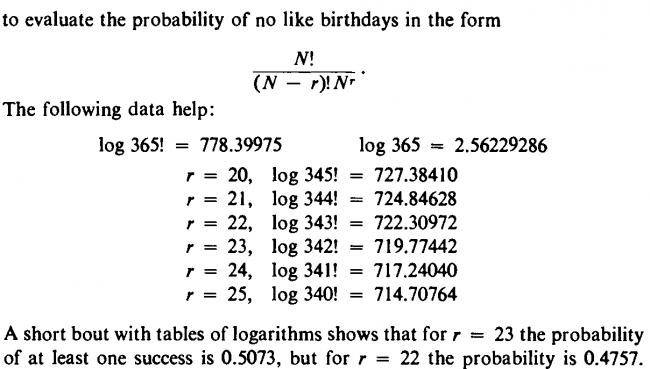same is the case whn we tk n=0
and moreover by bernollies trials combinations shd be used nt permutations
N people are there in a group. It is known that the probability that atleast two of them having common birthday is "P".
find the smallest N such that P is greater than 1/2
(This is an easy problem. Do not get intimidated by the language!!)
-
UP 0 DOWN 0 1 28

28 Answers
a good reference for this same problem could be
http://en.wikipedia.org/wiki/Birthday_problem
It is the very famous birthday problem :P
In the hind sight, this could be one of the most useless (calculative) problem that i have probably given here :P :|
I think I messed up with the leap year part. Otherwise was my approach right? Will be glad to recieve your comment on this :)
ans=23. for finding it easily we can use log table instead of 'man power'!!.
yes Varun is right
ne way
i think we can solve this only by manually calc is there any algebraic way varun
itz nt comparing...see like 1 or 0 person cn't hv common b'day,itz for sure
i didn't use permutations directly, honey. i just expressed the ans i got permutatory terms or whatever they are.
Yes i understood .. I got N = 23 when we consider only non-leap year.. Don't want to calc for leap year now :P
when you're comparing dob's of two or more persons, it's logical. But when you compare dob of a person with his own dob, you know it is going to always b equal. :)
I think the correct answer is..........data is insufficient.
Judging by the probability of atleast 2 users of targetiit.com having same dob, you cannot find the number of users [Maybe u can Nishantbhai but not us ;)].
Probability of two people having bday on same day is
(3/4) {1/(365)2} + (1/4) {1/(366)2}
PLEASE CORRECT ME IF I AM WRONG :)
@varun : thnx for pointing out mistake, machan! You're right. it should be (365)N. Did u understand the rest of the solution?
P.S: This is not anywhere near the final answer
x(or n) is the number of people having same birthdate... .. when n=1, p(n=1) = 0..
i.e. when number of people is 1, then 2 people can't have same birthdate
ys bt see acc to ques if u hv considered no person hving b'day on particular day thn y nt consider 1 person having b'day on particular day?
Probability of a person having the same dob as himself is always 1 :)
Explanation for my apparently bamboozling ans ;)
N is as mentioned in the question.
Probability of n presons getting the same dob is ,P(n)=
3/4 (1/365)n ------- not leap year
+ --------or
1/4 (1/366)n --------- leap year
n=0 => dob of each person is different
P(n=0) = 3 [ 365.364.363........(365-N)]
/4*(365)n
+
1 [366.365.364.........(366-N)]
/4*(366)n
Understood till now?
n≠1 as one person always has same dob as himself. We require,
P= P( atleast 2 have same dob)= P(n≥2)
=1-P(n=0)
Also,
P≥1/2
thus 1- P(n=0)≥ 1/2 and substitute for P(n=0). Hopefully you'll get what i got and prove me right ;)
No honey.. the answer is much larger..
You will have to do some trial and error to reach the final answer though! :(
That is the bad part of this question...
Hmm.. interesting...
Well the formula upstairs looks like something that i had studied when i was somewhere in my "teens". I dont remember exactly buy yeah.. some what that ;)
Now that I have made out what you had above! Let me see what you have written down below!
Well I was not too interested in the leap year thing! (Definitely not cos it Wasnt a puzzle [3]) but cos you have included that too, I had to think for a while.. and then think for another.. just to be sure... and then type this whole thing down just to say that you were right :)
CHECK IF FORMULA GIVEN BELOW IS CORRECT AND THEN PROCEED:
nPr = n(n-1)(n-2).........(n-r+1)(n-r)
IF INCORRECT PLS INFORM ME
IF NOT MAKE WHAT U CAN OF WHAT IS GIVEN BELOW ;)
I think you will get ans if.............. u solve the eq'n given below
3[365PN/(365)N]+ [366PN/(366)N] = 2 :)
I will give a very trivial example.
if P>0
then we know that there is atleast one user on targetiit.com
Otherwise there will be no user! (So i have one bound.. )
This might not be very insightful for the current problem. But I am not giving you any insight either.. :P
just trying to justify that the problem does make sense! :)
Ok.. let us put it like this.. find the smallest N such that the probability above is greater than 1/2
May be I messed up in my language.. :(